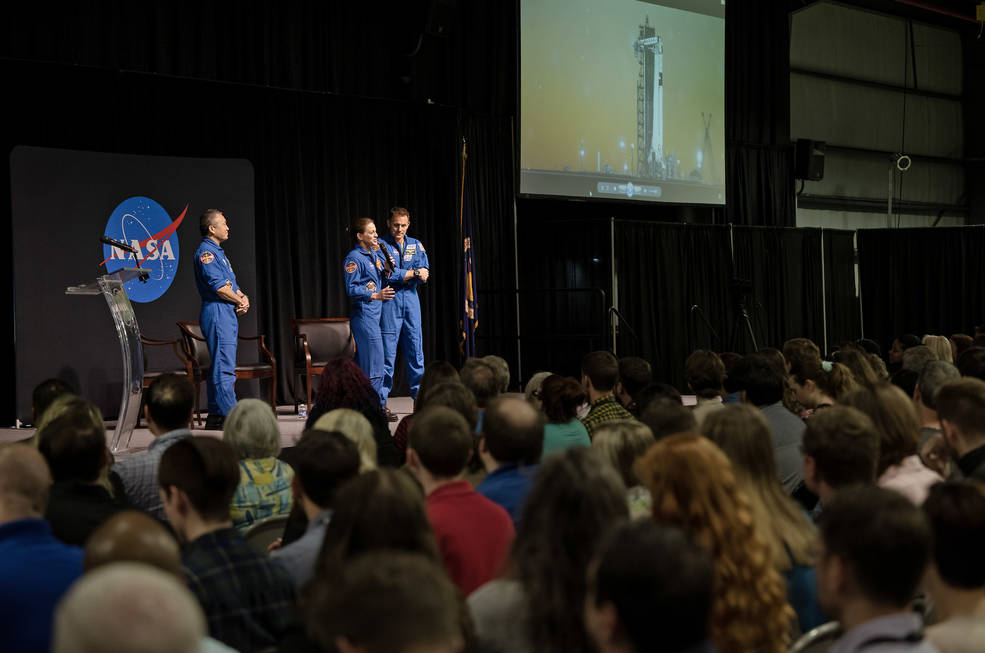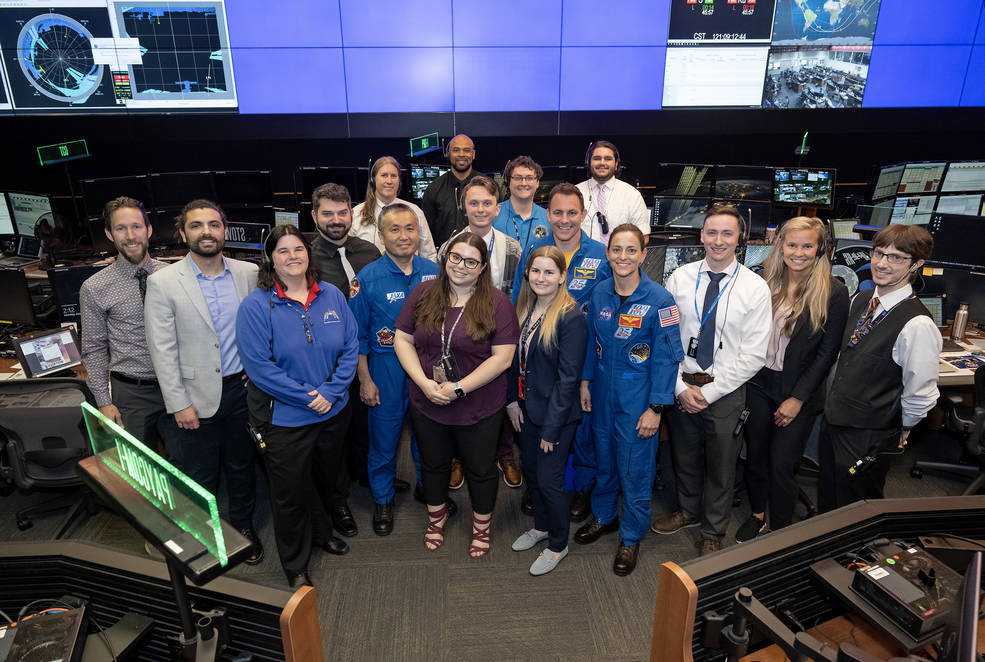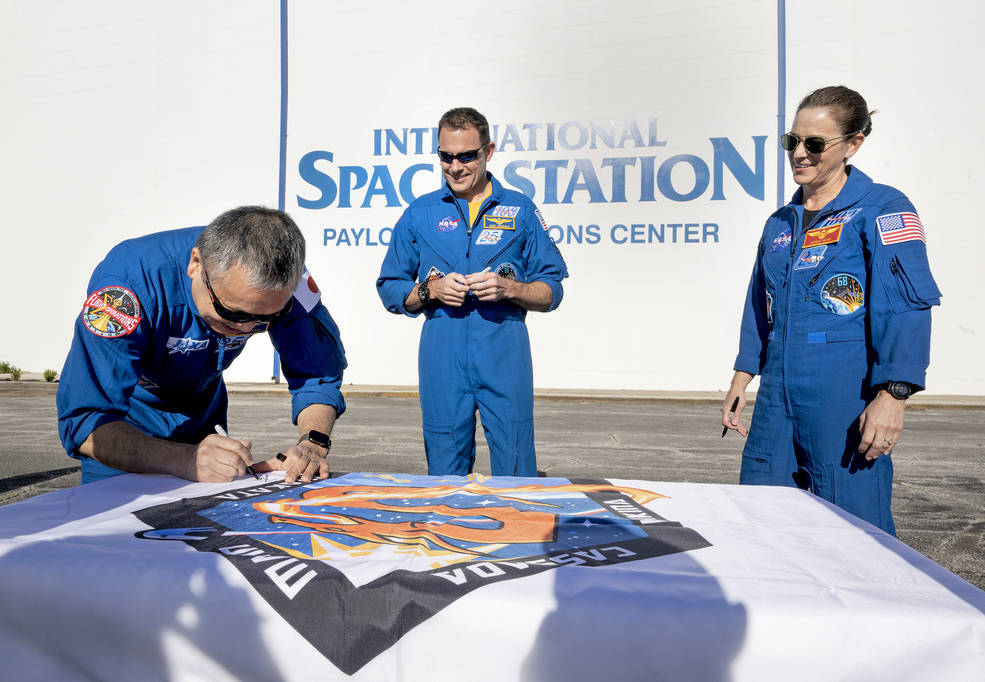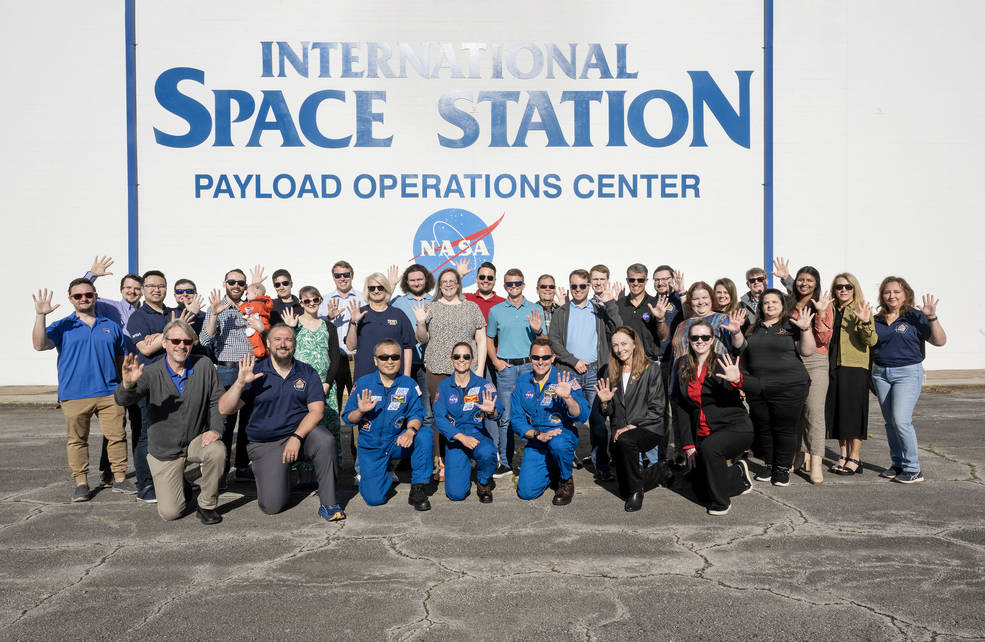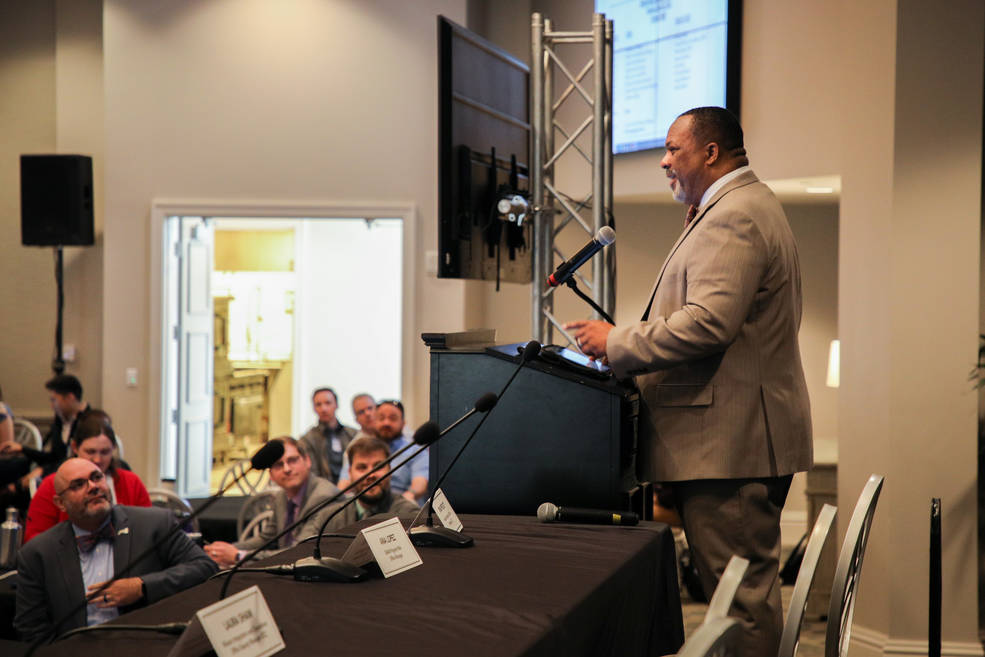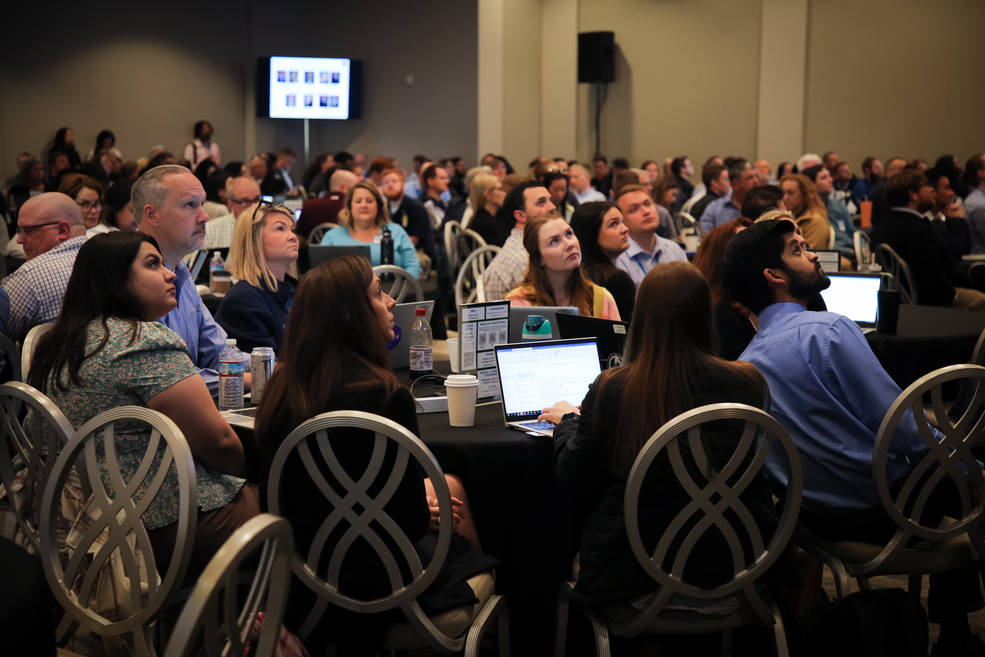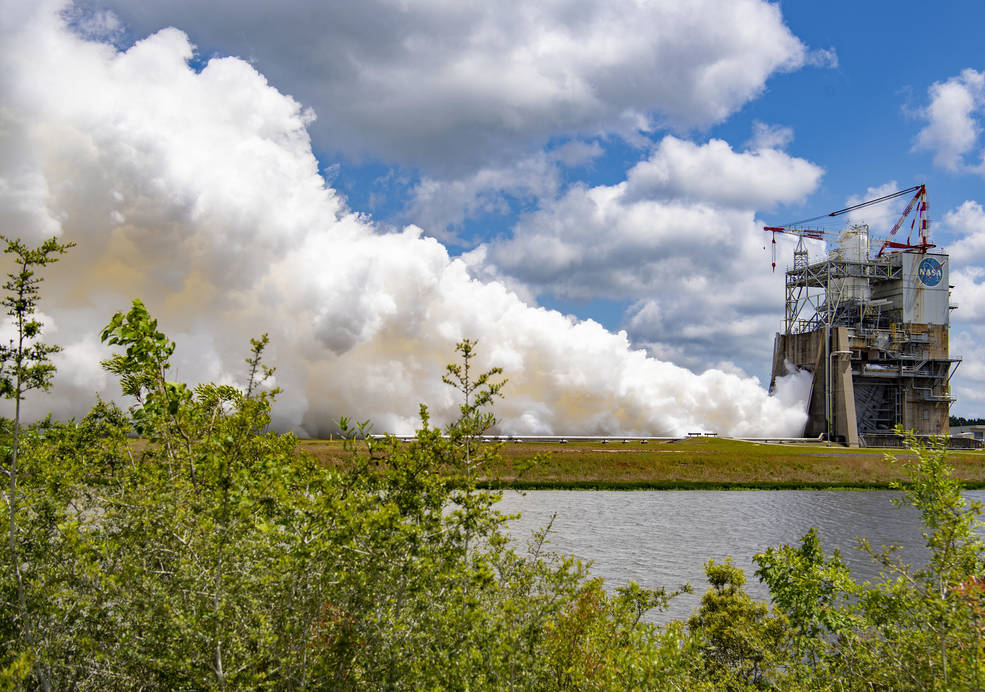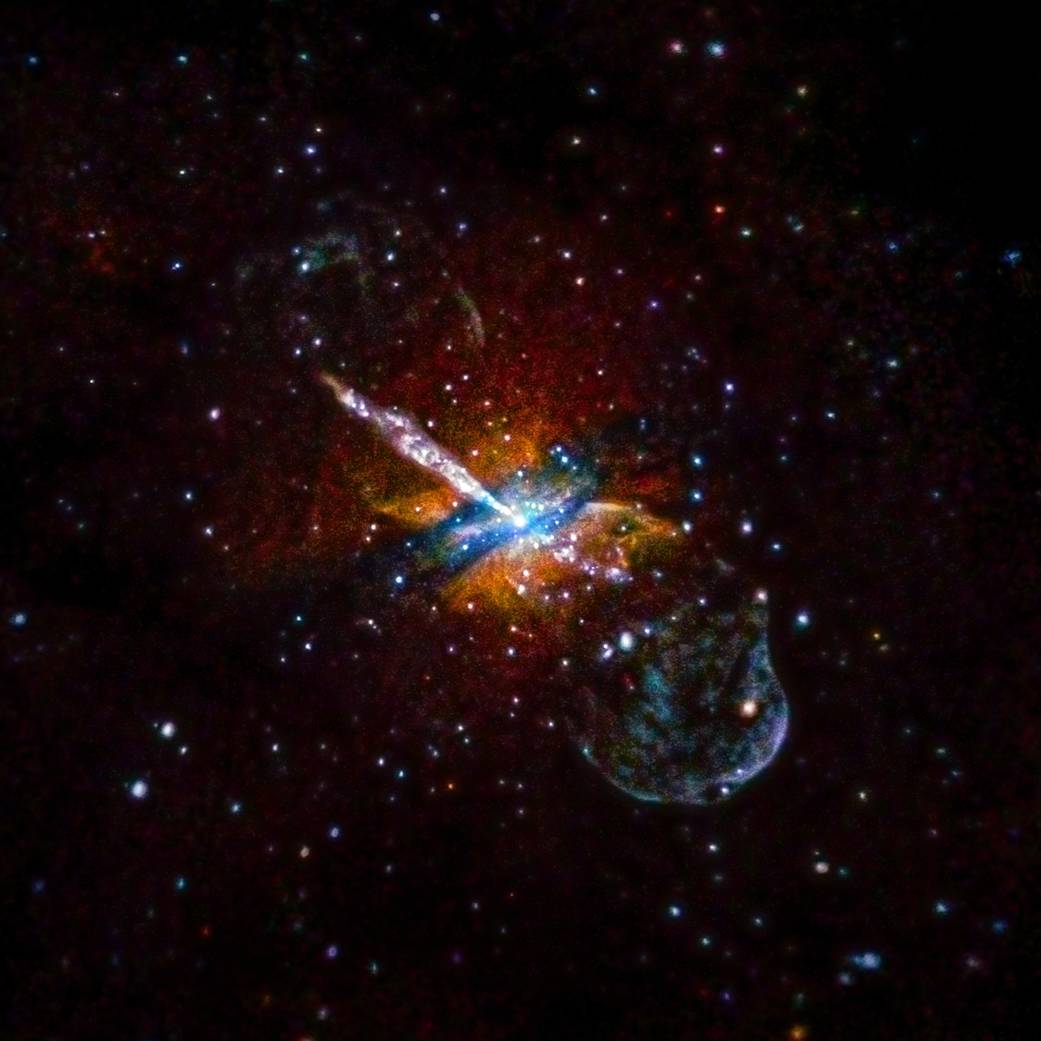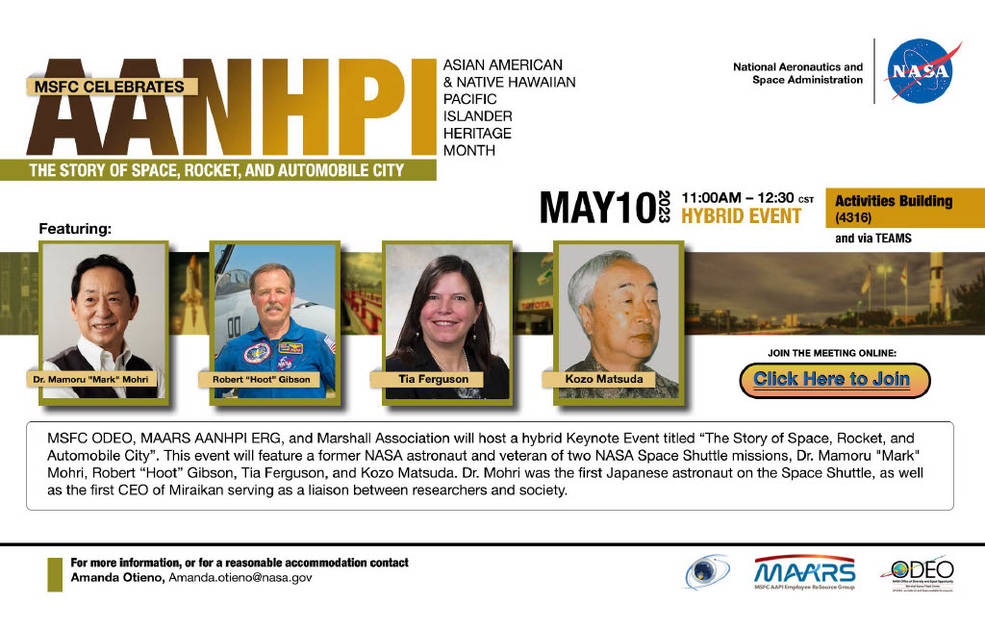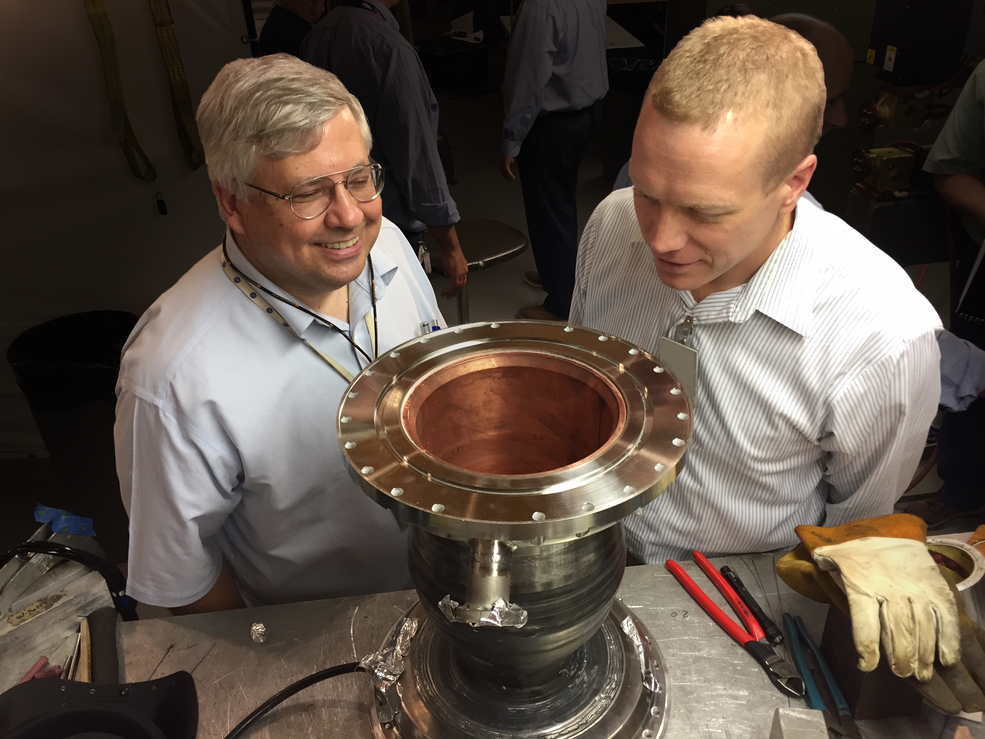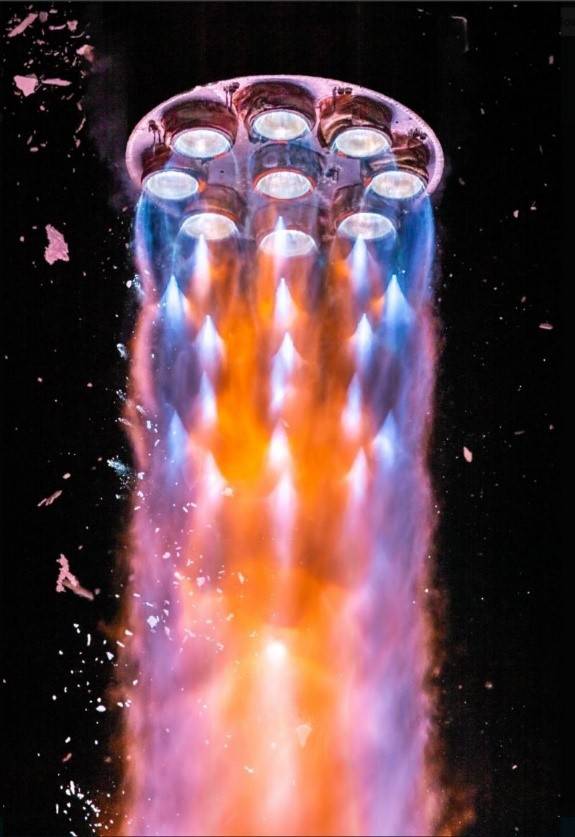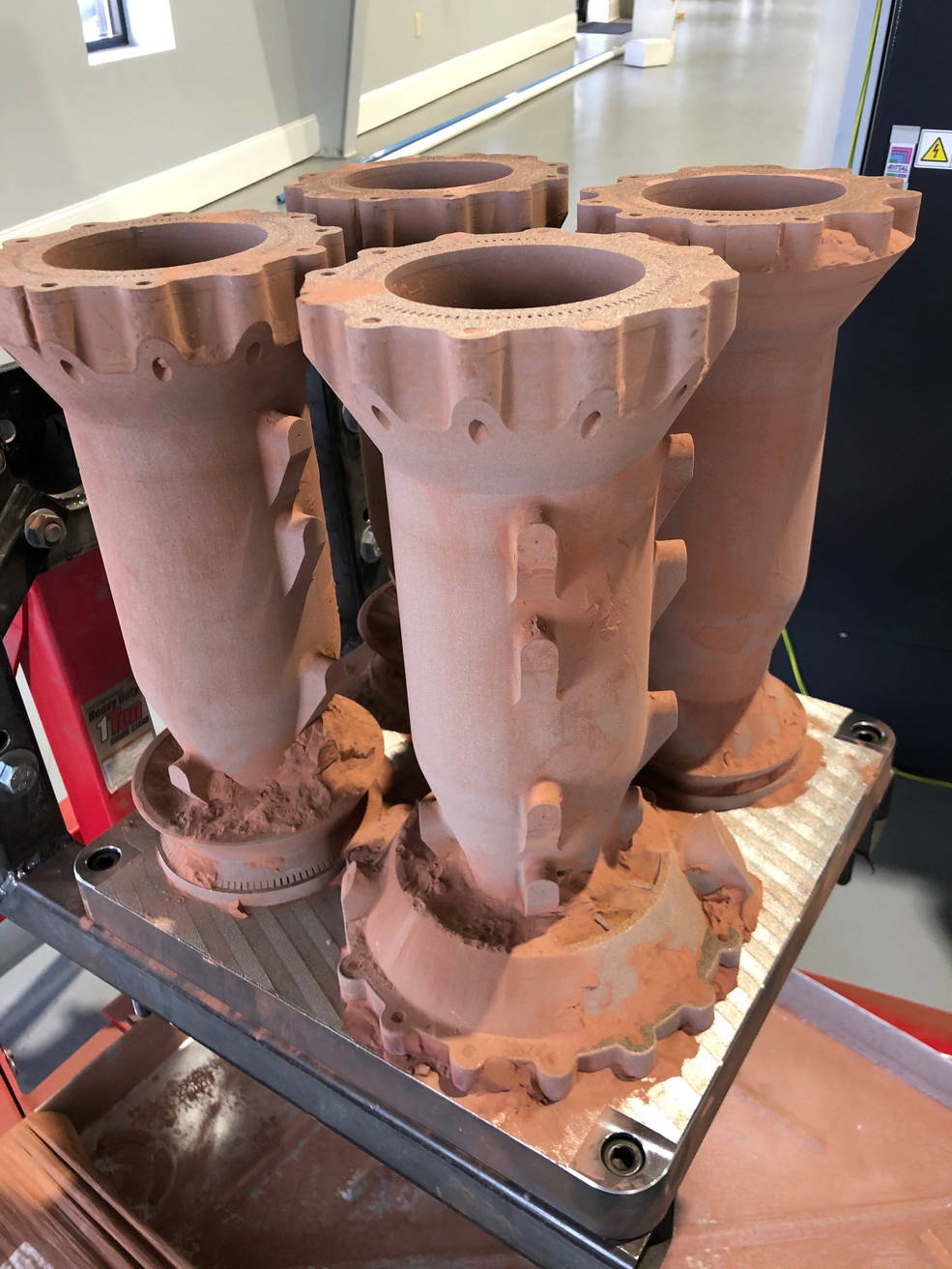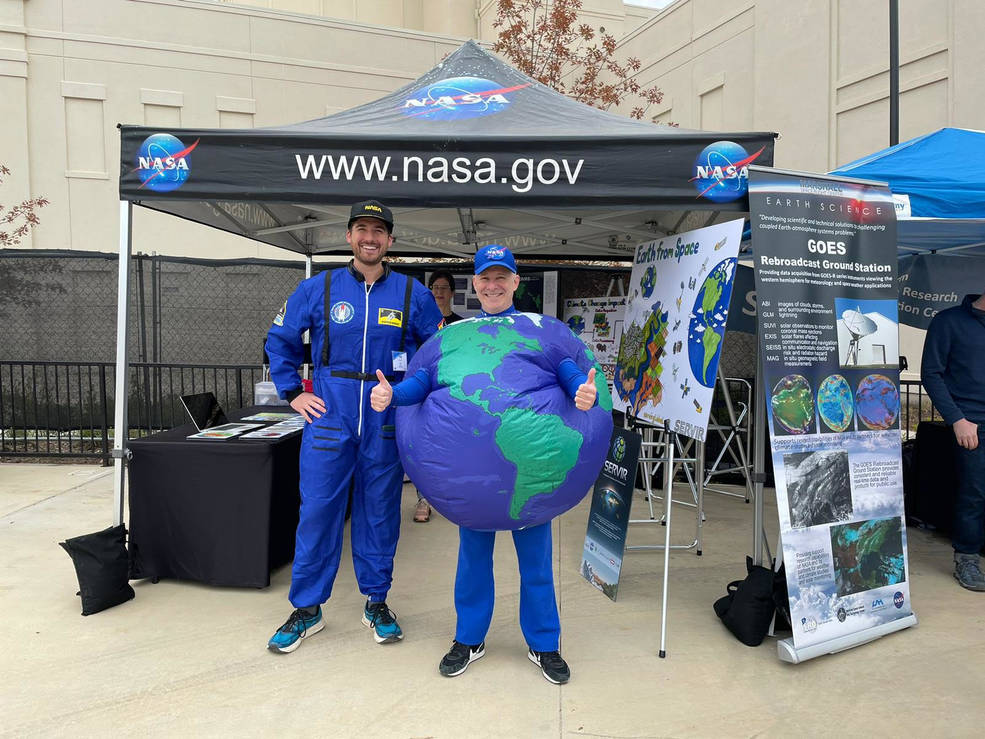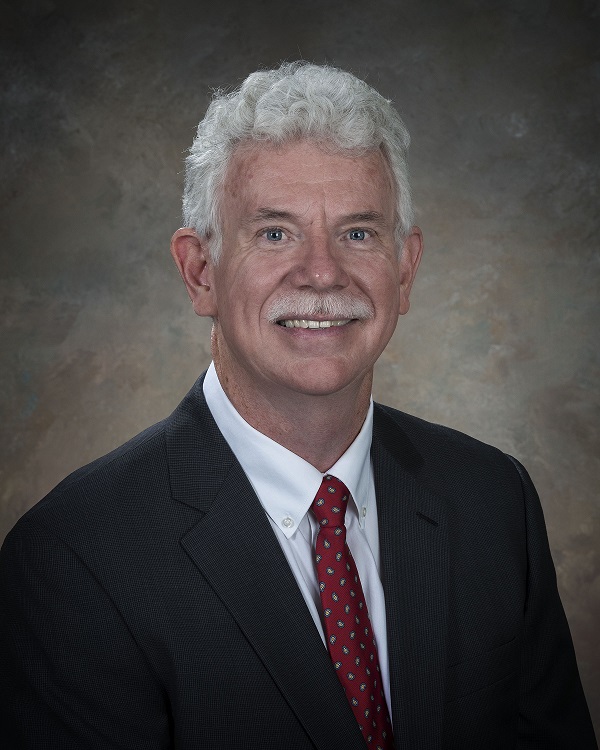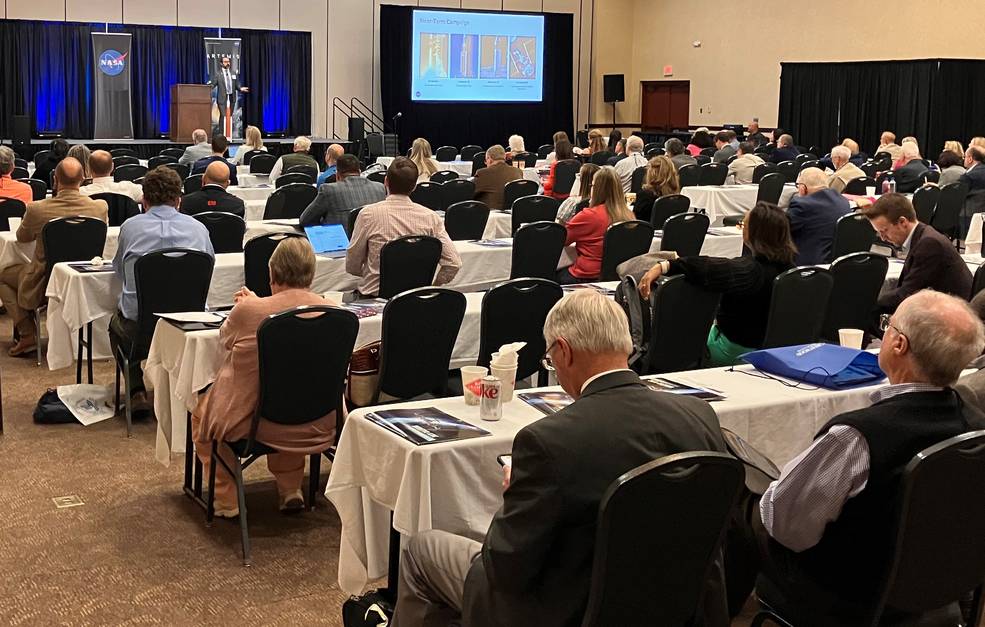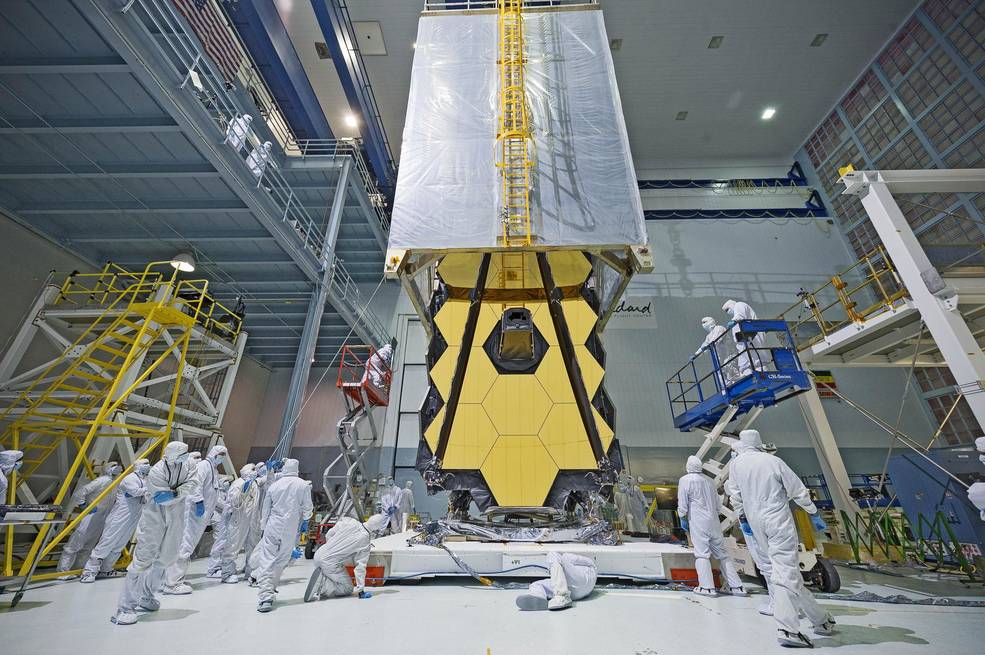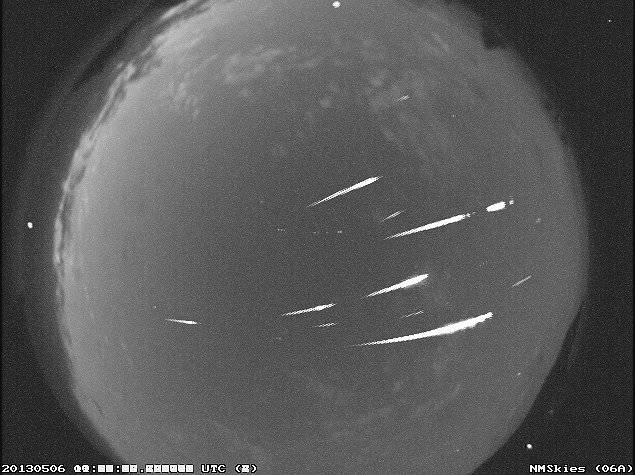The Marshall Star for May 3, 2023.
In This Week’s Star
- Crew-5 Astronauts Meet with Workforce, Share Mission Experiences
- Meeting Provides Review Platform for Payload Operations Integration Working Group
- NASA Tests Critical In-Flight Capability During RS-25 Engine Hot Fire
- Galaxy with Black Hole Shines in Image from NASA’s Chandra, IXPE
- Marshall to Celebrate AANHPI Heritage Month with Hybrid Event
- 3D Printed Rocket Launched Using Innovative NASA Alloy
- SERVIR, SPoRT Projects Highlighted at Huntsville Earth Day Event
- Welcoming Spring: A Time of Renewal and Change
- Alabama Physicians Attend NASA Presentation During Annual Medical Conference
- Webb Science Team Wins Wernher Von Braun Memorial Award
- Watch the Skies: Eta Aquariid Meteor Shower Outburst to Peak the Night of May 4-5
Crew-5 Astronauts Meet with Workforce, Share Mission Experiences
By Jonathan Deal
NASA’s Marshall Space Flight Center hosted the agency’s SpaceX Crew-5 mission astronauts on May 1 during a standing-room-only employee event of more than 400 people at Activities Building 4316, where the crew members discussed their mission to the International Space Station and met Marshall team members. This was the first time NASA astronauts engaged with the center workforce to share mission highlights since 2018, and the first employee event featuring commercial crew astronauts.
NASA astronauts Nicole Mann, Josh Cassada, and JAXA (Japan Aerospace Exploration Agency) astronaut Koichi Wakata, were part of the agency’s fifth commercial crew mission to the International Space Station, which launched in October 2022 on NASA’s SpaceX Crew-5 flight.
The international crew, which also included Roscosmos cosmonaut Anna Kikina, spent 156.5 days aboard the space station, traveled 66,577,531 miles, and completed 2,512 Earth orbits, splashing down off the coast of Tampa, Florida, on March 11. This was the first spaceflight for Mann, Cassada, and Kikina, and the fifth flight for Wakata who has now logged a total of 505 days in space.
During their stay on the space station, the Crew-5 members contributed to hundreds of experiments and technology demonstrations, including microgravity’s effects on the cardiorespiratory system, modeling heart tissue to improve therapies for spaceflight-caused health issues, and the 3D bioprinting of human organs and tissues for implantation, among multiple other types of research.
“We spend the majority of our time on station executing science, and it wouldn’t be possible without so many of you here making it happen behind the scenes,” said Mann at the employee event. “We are so fortunate to be your eyes and ears on the ISS.”
Mann told the audience that some of her most enjoyable memories on the space station included working on science experiments with Marshall team members.
“It’s really special to be able to meet you and your families today – if it wasn’t for you, this mission wouldn’t have been as successful as it was.”
The audience included team members from the Payload Operations Integration Center (POIC), who operate, plan, and coordinate the science experiments onboard the space station 365 days a year, 24 hours a day.
“The POIC is in charge of integrating all of the NASA payloads and experiments Crew-5 operated on-board the ISS,” said Carlos Barreto, Payload Operations manager. “We formed close relationships with the crew as we worked together to meet all of the science objectives during their six-month mission. The team was thrilled to welcome them and have the opportunity to meet them post-flight.”
During a small ceremony at the POIC, the Crew-5 astronauts signed and installed their mission patch in the POIC’s control room.
NASA’s Commercial Crew Program has worked with several American aerospace industry companies to facilitate the development of U.S. human spaceflight systems since 2010. Marshall’s commercial crew support team helped provide oversight to safety standards for the Crew-5 mission’s spacecraft, along with monitoring launch conditions.
“Our team at Marshall is proud to play a part in the success of Commercial Crew Program missions, including Crew-5,” said Lisa McCollum, Marshall Commercial Crew Program support manager. “Each mission is unique with its own challenges that must be overcome, so it is extremely rewarding for our team to see the Crew-5 astronauts back on Earth and here at Marshall after their safe and successful mission!”
NASA selected Boeing and SpaceX in September 2014 to transport crew to the International Space Station from the U.S. The goal is to have safe, reliable and cost-effective access to and from the International Space Station and foster commercial access to other potential low-Earth orbit destinations.
Jonathan Deal, a public affair specialist, supports Marshall’s Office of Strategic Analysis & Communications.
Meeting Provides Review Platform for Payload Operations Integration Working Group
Dwight Mosby, manager of the Payload and Mission Operations Division at NASA’s Marshall Space Flight Center, addresses audience members during the Payload Operations Integration Working Group meeting held at the Huntsville Botanical Gardens on April 25. The working group provided a platform for payload developers, investigators, and project managers to synchronize their procedures and timetables, along with examining the progress of scientific payloads that are presently on or expected to be launched soon to the International Space Station. International partners and industry professionals also attended the meeting, both in-person and virtually. The Payload Operations Integration Center at Marshall is the control center for scientific operations on the space station. (NASA/Eben Boothby)
Participants view the agenda at the biannual Payload Operations Integration Working Group meeting. (NASA/Eben Boothby)
NASA Tests Critical In-Flight Capability During RS-25 Engine Hot Fire
NASA carried out a critical hot fire of the redesigned RS-25 engine April 26 at NASA’s Stennis Space Center, demonstrating the gimbaling, or pivoting, capabilities needed to stabilize a rocket during a launch and flight to space.
Operators at the nation’s largest propulsion test site conducted the first gimbal test of the current RS-25 engine certification series on the Fred Haise Test Stand. The certification series is supporting lead engine contractor Aerojet Rocketdyne as it prepares to produce additional RS-25 engines for future SLS (Space Launch System) flights.
The new production includes engines for future Artemis missions to the Moon, as NASA returns humans to the lunar surface to establish a long-term presence for scientific discovery and to prepare for human missions to Mars.
During a 12-minute (720 seconds) hot fire, operators gimbaled the RS-25 engine using a NASA Stennis-developed system to enable pivoting of the engine, mirroring maneuvers needed during launch and flight of the SLS rocket. The 720-second hot fire marks the longest-duration test of an RS-25 certification engine in the current test series.
Gimbaling is the technique of pivoting, or swiveling, the engine a few degrees along a tight circular or back-and-forth axis to direct engine thrust and “steer” the rocket on a proper trajectory. It also plays a vital role to ensure the rocket maintains stability during flight to space. Four RS-25 engines, firing simultaneously, help power each SLS launch, producing more than 2 million pounds of combined thrust during the eight-minute flight to orbit.
The test team at NASA Stennis performed multiple gimbaling maneuvers during the test, pushing the capability to its limits to provide a margin of operational safety. For much of the April 26 test, the engine fired at the 111% power level, the level of thrust needed during launch. Operators briefly pushed the engine up to the 113% power level as well.
NASA and Aerojet Rocketdyne modified 16 engines remaining from the Space Shuttle program, which were proven flightworthy at NASA Stennis for Artemis missions I through IV. The current series of testing supports production of new RS-25 engines to help the Artemis V mission and beyond.
Under Artemis, NASA will land the first woman and first person of color on the Moon, establish long-term lunar science and exploration capabilities, and inspire the next generation of explorers – the Artemis Generation.
Galaxy with Black Hole Shines in Image from NASA’s Chandra, IXPE
The galaxy Centaurus A (Cen A) shines bright in this image combining data from multiple observatories. In the center of this galaxy is a supermassive black hole feeding off the gas and dust encircling it, and large jets of high-energy particles and other material spewing out. The jet shown at the upper left of this image extends for about 13,000 light-years away from the black hole. Also visible is a dust lane, wrapping around the middle of the galaxy, which may have resulted from a collision with a smaller galaxy millions of years ago. Black Hole Week is celebrated during the first week of May.
Colors in this image have been chosen to reflect the sources of data. Blue shows X-ray light captured by NASA’s Chandra X-ray Observatory, orange represents X-rays detected by NASA’s Imaging X-ray Polarimetry Explorer (IXPE) satellite, and optical light seen by the European Southern Observatory in Chile is colored white and gray.
Cen A has been studied extensively since the launch of Chandra in 1999. With IXPE, which launched in 2021, scientists can understand the mysteries of this object in a new way. IXPE is specialized to look at a property of X-ray light called polarization, which relates to the organization of electromagnetic waves. This specialized measurement is helping scientists study how particles become accelerated to high energies and speeds – nearly the speed of light – at extreme cosmic objects like this one.
At Cen A, researchers using IXPE seek to understand what causes the X-ray emission in the jets. So far, scientists have not detected X-ray polarization at Cen A, indicating that particles much heavier than electrons, such as protons, are not producing the X-rays. More insights are to come as scientists analyze the data.
Cen A is found 12 million light-years from Earth in the constellation Centaurus and represents the fifth brightest galaxy in the sky.
NASA’s Marshall Space Flight Center manages the Chandra program. The Smithsonian Astrophysical Observatory’s Chandra X-ray Center controls science operations from Cambridge, Massachusetts, and flight operations from Burlington, Massachusetts.
Part of NASA’s Small Explorer mission series, IXPE launched on a Falcon 9 rocket from NASA’s Kennedy Space Center in December 2021. It now orbits 370 miles, or roughly 595 kilometers, above Earth’s equator. The mission is a partnership between NASA and the Italian Space Agency, with partners and science collaborators in 13 countries. Ball Aerospace, headquartered in Broomfield, Colorado, manages spacecraft operations.
Marshall to Celebrate AANHPI Heritage Month with Hybrid Event
The first Japanese astronaut to fly on the space shuttle will be one of four featured guests at a hybrid Asian American & Native Hawaiian Pacific Islander (AANHPI) Heritage Month event set for 11 a.m. May 10 at NASA’s Marshall Space Flight Center. The event will be in-person in the Activities Building (4316), and also via Microsoft Teams. Marshall’s Office of Diversity and Equal Opportunity, Marshall’s AANHPI Employee Resource Group, and the Marshall Association will host the event, titled “The Story of Space, Rocket, and Automobile City.” Dr. Mamoru “Mark” Mohri, who participated in two NASA space shuttle missions and is also the first CEO of Miraikan, will be joined by Robert “Hoot” Gibson, Tia Ferguson, and Kozo Matsuda. For more information or accommodations, contact Lien Moore or Amanda Otieno. (NASA)
3D Printed Rocket Launched Using Innovative NASA Alloy
In March, the Relativity Space Terran 1 rocket lit up the night sky as it launched from Cape Canaveral Space Force Station. This was the first launch of a test rocket made entirely from 3D-printed parts, measuring 100 feet tall and 7.5 feet wide. A form of additive manufacturing, 3D printing is a key technology for enhancing capabilities and reducing cost. Terran 1 included nine additively manufactured engines made of an innovative copper alloy, which experienced temperatures approaching 6,000 degrees Fahrenheit.
Created at NASA’s Glenn Research Center under the agency’s Game Changing Development program, this family of copper-based alloys known as Glenn Research Copper, or GRCop, are designed for use in combustion chambers of high performance rocket engines. A combination of copper, chromium, and niobium, GRCop is optimized for high strength, high thermal conductivity, high creep resistance – which allows more stress and strain in high temperature applications – and good low cycle fatigue – which prevents material failures –above 900 degrees Farenheit. They tolerate temperatures up to 40% higher than traditional copper alloys, which leads to higher performance components and reusability.
In the late 1980s, NASA wanted to develop an engine for maneuvering spacecraft in low-Earth orbit that could withstand multiple firings. Rocket engines encounter complex challenges in design and environments in which they operate, including multiple startups and shutdowns that create a cycle of wear and tear on critical components.
Dr. David Ellis developed the GRCop family of alloys as a NASA-supported graduate student during the space shuttle era. He continued to mature the alloys and their applications throughout his career.
“At the time, Space Shuttle Main Engine combustion chamber liners were typically replaced after one to five missions,” explained Ellis. “Our research was able to show that GRCop-84 would easily meet the goal of 100 missions between maintenance service and 500 missions of engine life.”
Throughout years of alloy development, Ellis and his team worked with multiple projects and programs, like NASA’s Rapid Analysis and Manufacturing Propulsion Technology (RAMPT), to advance different versions of GRCop alloys. The most recent iteration, named GRCop-42, uses a variety of additive manufacturing methods to create single-piece and multi-material combustion chambers and thrust chamber assemblies for rocket engines. These processes improved the performance, while significantly reducing weight and costs of thrust chamber components.
NASA found that the GRCop alloys pair very well with the latest additive manufacturing methods. Modern manufacturing methods such as laser powder bed fusion and directed energy deposition are two approaches that can be used to build GRCop parts for many aerospace applications, such as the Terran 1 rocket engines.
In laser powder bed fusion, a 3D computer model is sliced into thin layers digitally. Then, a powder bed machine, which acts like a printer, begins a process of spreading and fusing thin layers of powder atop one another, thousands of times over to form a complete part. This process of bonding layers together results in materials strength that is comparable to forged metal. The advantage of this method is that finely detailed parts can be created, such as nozzles and cooling channels used for combustion chambers and nozzles.
The directed energy deposition (DED) process uses a laser to create a melt pool. Powder is then blown into the melt pool and cools creating solid material. The 3D motion of a robot directs the building process to create the entire part with the laser and blown powder. The DED process produces larger shapes and components compared to laser powder bed fusion, but with fewer fine details.
“Development projects, like RAMPT, allow advancement of new alloys and processes for use by commercial space, industry, and academia,” said Paul Gradl, principal engineer at NASA’s Marshall Space Flight Center. “NASA takes on the development risk and matures the process from early material and process concepts through certification. This infusion of GRCop-42 alloys into commercial space is another great example of how NASA-led innovations advance industry capabilities and contribute to America’s growing space economy.”
Under a reimbursable Space Act Agreement, NASA provided technical expertise to Relativity Space that moved GRCop-42 from development into a flight-ready product used to launch the Terran 1 rocket. Relativity Space has shown these higher performing rocket engine components, produced by additive manufacturing with GRCop alloys, could be used in future missions to the Moon, Mars, and beyond.
Game Changing Development is part of NASA’s Space Technology Mission Directorate, which develops new cross-cutting technologies and capabilities for NASA’s current and future missions.
SERVIR, SPoRT Projects Highlighted at Huntsville Earth Day Event
NASA SERVIR’s Regional Science Lead Tim Mayer, left, dressed as a NASA astronaut, and SERVIR’s Program Manager Dan Irwin, right, sporting an Earth costume, promote NASA at the Orion Amphitheater’s Earth Day event in Huntsville on April 23. NASA Marshall Space Flight Center’s Earth Sciences Branch representatives engaged with those attending to demonstrate the SERVIR and Short-term Prediction Research and Transition Center (SPoRT) projects. They showed how Marshall works with national and international stakeholders and end users, enhancing their capabilities by using satellite remote sensing data of the Earth and atmosphere toward Earth action and decision-making. (NASA)
Welcoming Spring: A Time of Renewal and Change
Dear Marshall family,
Welcome to spring! The grass is growing, flowers are blooming, and trees are dressed in leaves again. Spring is a wonderful time of renewal and change. In the past, I’ve used the season in letters, such as this one, to illustrate that change is inevitable and renewal can come even when things may seem the bleakest.
We now find ourselves three years out from the beginning of the COVID-19 pandemic. Some of the changes we’re facing at this point arise from trying to discover and establish a “new normal.” During the height of the pandemic, when things were in such a state of chaos and uncertainty, I strongly resisted the urge to join others in using that term. But now we’ve hopefully moved beyond the most dangerous and disruptive stages of COVID’s impact on our world, and we do have the opportunity to influence how things will look, going forward.
For better or worse, however, we’ve accumulated some baggage over the past three years that needs to be addressed as we move forward. In our attempts to stay safe during the pandemic, most of us significantly restricted our in-person contact with others. I’ve heard from many people who said – particularly during the first year – the only time they went out into a public place was to buy groceries. It was wonderful to have the option to stay at home and limit our exposure to others who might have increased our risk of severe illness. But that option also came with some costs. For some, the resultant isolation and loneliness led to increased anxiety and depression. And for many, it led to an increased focus on self and a corresponding increased wariness of others, both of which persisted long after the worst of the pandemic had passed. Add to this the news of repeated instances of social injustice, mass violence, and natural disasters, and it’s no wonder that many of us are more on-edge than usual.
While we most often have no influence on the bad things that happen in the world around us, we can control how we react, and how that translates into the way we treat others. Each one of us has both the opportunity and the responsibility to do what we can to help keep the bad behavior that happens in the world around us from becoming bad behavior in our workplace. Doing so takes a good deal of deliberate effort. We’re all human, after all, and consequently, we all make mistakes. Even with the best of intentions, we sometimes do or say things that are offensive, hurtful, or undermining. As I offer the following tips to help us do better, I also respectfully ask you to join me in genuinely taking this topic to heart and considering what you can do to make the great work environment at Marshall even better. Please consider the following:
- We can be deliberate in treating others with dignity and respect.
- We can treat each person as the individual they are, rather than acting upon our assumptions about them.
- We can pause and think about what we’re saying and/or doing, and how it might impact others. Often, our good intentions are lost among unexpected negative impacts upon the other person.
- We can try to get into a habit of assuming that everyone is dealing with some type of struggle in life, and that most people are doing the best that they can. Showing some kindness, rather than frustration, could make a huge difference in someone’s day, and ours too.
- We can try to stop taking everything so personally, and thinking we have to take a side in every disagreement or battle, even when it has nothing to do with us or the greater good.
- When a problem is being worked, we can keep the focus on the problem, rather than attacking the person who has a perspective different from our own.
- We can stand up for others when we see or hear them being mistreated.
So, as we consider the many ways we can help to shape our new normal, let’s all work together to ensure creating a work environment that’s civil and psychologically safe is high on our list of priorities.
Stay safe and well,
Dr. Terry Sterry
Licensed psychologist and Marshall Employee Assistance Program coordinator
The Employee Assistance Program (EAP) is available to assist Marshall team members with challenges, or to simply facilitate discussions related to mental health and well-being. For more information, visit the Employee Assistance Program page on Inside Marshall.
Alabama Physicians Attend NASA Presentation During Annual Medical Conference
More than 200 physicians listen as Ian Maddox, a Marshall habitation systems architect, delivers the keynote presentation for the Medical Association of the State of Alabama during their 2023 Annual Meeting and Business Session on April 28 at the Von Braun Center in Huntsville. Maddox discussed NASA’s efforts toward enhancing astronaut health and safety, mitigating inherent risks, and ensuring successful human mission performance during future long-duration missions to the Moon and Mars. (NASA/Chris Blair)
Webb Science Team Wins Wernher Von Braun Memorial Award
The National Space Society (NSS) has awarded the Wernher von Braun Memorial Award to NASA’s James Webb Space Telescope’s science team. The award will be accepted at the NSS’s 23rd annual International Space Development Conference, to be held on May 25-28, 2023, in Frisco, Texas, a suburb of Dallas.
The Wernher von Braun Memorial Award is given in odd-numbered years to recognize excellence in management of and leadership for a space-related project that is significant and successful and shows strong management skills and team cohesion.
Accepting the award will be Dr. Eric Smith, the associate director for research in the Science Mission Directorate’s Astrophysics Division at NASA Headquarters in Washington and program scientist for the James Webb Space Telescope.
“On behalf of NASA’s James Webb Space Telescope team, we are honored by this prestigious award,” said Dr. Eric Smith, associate director for research in the Astrophysics Division at NASA Headquarters and program scientist for the James Webb Space Telescope. “Webb has exceeded all expectations and captured awe-inspiring images and amazing spectra of the distant universe, objects in our solar system and everything in between that will inspire generations to come.”
Launched in late 2021 after more than a decade of preparation, Webb successfully performed a complex series of deployments shortly after leaving Earth orbit. The process required over 400 specific mechanical actions, none of which had been tested in microgravity.
Six months later, the telescope reached its working orbit at the Sun-Earth L2 Lagrange point, a stable orbit in space well beyond that of the Moon. Once there and fully commissioned, the 21-foot telescope began its record-breaking work.
Webb operates at infrared frequencies. The combination of sensitive instrumentation with its massive primary mirror the telescope can see farther and more clearly than any previous observatory of its kind. Discoveries from existing and newly identified targets began to accumulate almost immediately. The first images were unveiled on July 12, 2022.
The ever-growing list of Webb discoveries includes direct imaging of exoplanets and the identification of key gases in their atmospheres; tracking clouds on Saturn’s moon Titan; identifying new details in a cluster of galaxies; imaging the incredibly faint rings around Uranus; capturing the galactic merger of Arp 220; discovering sand-bearing clouds on a remote exoplanet; measuring the temperature of a rocky exoplanet; and observing galaxies seen in their earliest years, when the universe was just 350 million years old – about two percent of its current age.
“The JWST has transformed how we look at the universe in a remarkably short period of time,” said Anita Gale, CEO of the NSS. “After its very nearly flawless deployment, a major feat in itself, the Webb has returned incredible science from the furthest reaches of the universe to never-before-seen details of our own solar system, with NASA coordinating research teams and partners from around the world. I can’t think of a more worthy recipient for this prestigious award.”
The National Space Society was founded in 1987 via a merger of the National Space Institute and the L5 Society.
The James Webb Space Telescope is the world’s largest, most powerful, and most complex space science telescope ever built. Webb will solve mysteries in the solar system, look beyond to distant worlds around other stars, and probe the mysterious structures and origins of the universe and our place in it. Webb is an international program led by NASA with its partners, ESA (European Space Agency) and the Canadian Space Agency. Several NASA centers contributed to the project, including Marshall Space Flight Center. Read more about Marshall’s work for the mission.
Watch the Skies: Eta Aquariid Meteor Shower Outburst to Peak the Night of May 4-5
The eta Aquariid meteor shower is active throughout April and May, peaking in the pre-dawn hours of May 5. This year could be particularly impressive as an outburst year with 120-160 meteors per hour expected.
“A meteor shower is like a normal rain shower, with 50-60 meteors per hour,” said Bill Cooke, lead of NASA’s Meteoroid Environments Office at the agency’s Marshall Space Flight Center. “An outburst is like a thunderstorm, with greater than normal meteor activity expected. A meteor storm is like a tornado, where meteor rates are over 1,000 per hour.”
Despite the full moon lighting up the sky and washing out the faint meteors, this year’s eta Aquariid meteor shower is not one to miss. In terms of producing fireballs, NASA camera data places it No. 6 among meteor showers. These bright fireballs are caused by Earth running into a dense stream of debris from Comet Halley, a lot of which was ejected more than 3,000 years ago. Moving at 148,000 mph, some of these fireballs leave glowing “trains” in their wake that last for several seconds to minutes.
The eta Aquariid meteor shower is viewable in both the Northern and Southern hemispheres, with higher rates of visibility to observers in the Southern Hemisphere. This is due to the radiant’s location in the constellation of Aquarius. Meteors will be observable after midnight, but the peak times are 3-4 a.m. until dawn.
Regardless of your geographic location, you’ll want to find an area well away from city lights for best viewing. Give yourself about 30 minutes in the dark for your eyes to adapt – this means not looking at your phone. Look away from the moon and take in as much sky as possible.
The next major meteor showers will be the Perseids in August, and the sister show to the eta Aquariids, the Orionids in October.
For more on this month’s sky, visit What’s Up in May from NASA Jet Propulsion Laboratory.


























